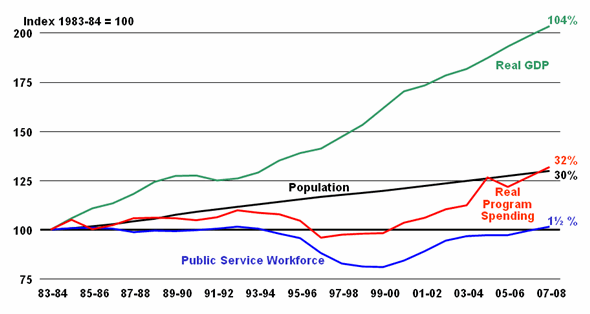Common menu bar links
77th Annual Couchiching Conference: Globalization, Knowledge and Competitiveness
By Kevin G. Lynch
Clerk of the Privy Council, Secretary to the Cabinet and Head of the Public Service
August 8 , 2008
Couchiching (Ontario)
Introduction
Thank you for the kind invitation to participate at the 2008 Couchiching Conference. It is an honour for anyone who loves public policy debates. Couchiching, with its rich history, this unique setting and the unparalleled scope of timely issues it has tackled over its 77 years, is a wonderful Canadian public policy asset.
The topic of this year’s Couchiching conference, “The Power of Knowledge: The New Global Currency”, is one of the most profound developments of our time. Underscoring this, the Conference program states that “this explosion of knowledge is changing the nature of global economics, politics, material life, the nature of work, and the ways in which we interact”. I happen to agree, but there are naysayers who ask what’s new, that if you were to ask any ancient Roman they too would extol the transforming impacts of knowledge, trade, investment and migration; that people experiencing the Industrial Revolution probably felt it too was rather profound and that the rise of the U.S. in the early 20th century completely reshaped global economics and power. Indeed, they might side more with the sentiment of Yogi Berra who once remarked, “The future ain’t what it used to be.”
Perhaps, but what is different today is the scale, scope and pace of change: the speed of knowledge generation, the pervasiveness and depth of globalization and the unique multiplying impacts of ICT (information and communications technologies). The modern wealth of nations is now driven not only by physical capital and human capital but also to an extent never seen before, by intellectual capital and the dynamic interaction amongst them called innovation. In today’s world, Canada’s new competitors are as likely to originate in Shanghai or Hanoi as in New England or Michigan, the knowledge breakthroughs are as possible from Helsinki or Singapore as from Oxford or MIT, and we will likely learn about it on the web before journals, newspapers or television report it.
In short, the times they are a-changing. These driving factors, as Fareed Zakaria observes in “The Post-American World”, have both enabled and propelled the “rise of the rest”. And “the rest” is no longer second tier: the world’s tallest building is in Dubai not the U.S. or Europe; the world’s largest shopping mall is in Beijing not Chicago; the largest movie industry is Bollywood not Hollywood; the world’s largest traded company is Chinese not European or American; and the world’s richest person is Mexican. Economically at least, we live in an increasingly multi-polar world.
The Competition Policy Review Panel, chaired by Mr. L.R. Wilson, and its report “Compete to Win”, make a similar observation from a more Canadian vantage point: “In the new world economy, Canada must be ready to keep pace with change and develop a global mind-set that is open to two-way trade, investment and talent. Canada’s economic success will be determined by how well we deal with the economic, social and political forces that are driving globalization.”
Canada @ 150
In the Public Service of Canada we have recently launched, as part of our public service renewal, a “Canada @ 150” initiative. It draws together 150 of our brightest young public servants and asks them, over the next year, to reflect on Canada in 2017, when our country celebrates its 150th anniversary. They have been asked to explore the nature of Canada’s challenges and opportunities along the way to 2017. Instinctively, they will think globally and multiculturally; they will network non-hierarchically and non-structurally; they will extrapolate not interpolate; and there will not be a pen or piece-of-paper or telephone in sight.
What about us here today, where do we see Canada at 150 in this dynamic knowledge-based global economy? How will it compare to Canada at 100, or Canada today? Is the status quo a good predictor of our future or a better descriptor of our past? Many good questions, few definitive answers, and much analysis needed. To quote Yogi Berra again: “It’s tough to make predictions, especially about the future”. True, but it is one thing to be surprised by unexpected events and another to miss clear trends.
Global Trends Not to be Ignored
What are those trends? Pervasive globalization has changed the nature of the markets for capital, goods and services and information. Global capital markets now operate 24/7, reducing global borrowing costs and raising global returns to lenders. But, as the implications of the U.S. subprime mortgage meltdown have amply demonstrated, a mis-pricing of risk in a national market can have global consequences. In goods markets, global supply chains now dominate manufacturing processes, reducing costs for producers and lowering prices for consumers. But, as the implications of recent product recalls have demonstrated, if supply chain quality control standards are not consistent and transparent, products may carry more risk than consumers believe, reducing confidence in brands and even markets. Global information markets have now emerged, propelled by soaring micro-chip power, plummeting bandwidth costs and the internet. But, along with a transformative real-time global information marketplace have come the challenges of cyber-crime, cyber-security, and cyber-sovereignty.
Growth and progress are not preordained. Whereas innovation has been an important driver of developed country growth in recent decades, it was economic reforms, introduced in the late 1980s and early 1990s that have propelled developing countries like India and China. Both India and China have enormous unit labor cost advantages, with weak productivity more than offset by very low wages. They have become critical cogs in global supply chains, creating a mutual interdependence. The impact of “the rise of the rest”, particularly China, is such that it has led to a significant redistribution of world GDP, a shift in global trade patterns and a rise in commodity and energy prices to record levels (Chart 1).
And how has this shifting global growth affected the pecking order of countries by size (Chart 2)? Flash back first twenty odd years to 1987. The economic wunderkind was Japan, expected by many to soon supplant the United States. China was just starting to edge into these league tables along with India and Brazil, Russia was inching out, and Canada was a member of the G-7 and the seventh largest economy in the world. Fast forward to 1997. Japan was by then mired in interminable stagnation, China and Brazil were moving up but China had not yet begun to gallop, Russia had exited, and Canada had slipped to ninth. Skip forward to today: the U.S. still dominates the world economy; China has the fourth largest economy and is gaining rapidly on Germany; India, Brazil and Spain are all in the top dozen; Russia is back; and Canada remains the world’s ninth largest economy.
Does this suggest an inevitability of declining Western competitiveness? Not at all. Consider the iPod, which is now assembled in China and is presented by some as proof positive of growing Chinese dominance in technically advanced products. The iPod is certainly such a product but, as Chart 3 shows, Chinese assembly only accounts for 10% of the final selling price, innovation accounts for 40% and distribution and retail sales for 50%. In other words, most of the value in the iPod comes from the concept, design and marketing. This points to the importance of R&D, highly qualified labour, risk-taking and innovation as the real drivers of value notwithstanding the importance of the global supply chain in the production of a product.
Interestingly, both China and India understand that their challenge is not to keep wages low but to improve quality. They are investing in knowledge. In 1985, only 234 PhDs graduated from Chinese universities; by 1995, China produced the same number of PhDs as Canada (4,000); today, China is graduating almost 30,000 doctorates, more than half of the total U.S. annual output and the gap is closing. Non-OECD countries are now growing players in global science and innovation (Chart 4).
Thankfully, size and wealth are not necessarily flip sides of the same coin. While the U.S. is the world’s largest economy and its people are the richest (after Luxembourg and Norway), what emerges clearly from extensive research across many economies is that high productivity countries are high wealth countries. And here Canada does well, but could do better still by increasing its productivity relative to the best performers among OECD countries.
Canada Towards 150
One thing we know about Canada at 150 is that our population --- where it lives and where its origins are --- will be very different from Canada at 100, let alone Canada at 50. Demographics are changing Canada: we are ageing; we are more ethnically diverse; more of us are living in cities; and we have much higher proportions of women in the workplace and graduating from our universities and colleges. By 2017, Canada will have a population approaching 35 million which will be highly multicultural (over 20% of Canadians will be visible minorities). In two major cities, Toronto and Vancouver, visible minorities will then be the majority.
How well off will our children be when Canada hits 150? That depends to a large extent on productivity growth. To many, the term productivity growth at best conjures up visions of obscure technical jargon, and at worst, the dread that workers will have to work more for less. While the former is true to all but the most die-hard economists, the latter is absolutely not. In effect, productivity lies at the heart of a country’s living standards --- it drives our earnings as individuals, and as a country.
While productivity levels are reasonably high in Canada (Chart 5) today, they are significantly less than the United States, and their rate of growth, which drives sustainable annual increases in earnings, has been less than in a number of other rich OECD countries in recent years. And this matters, to each and every one of us --- our living standards are less than the U.S. (17% by common measures), and this affects real choices at the household level (Chart 6).
Looking ahead, the challenge for Canada is to increase productivity growth, and to do so in the challenging context of today’s knowledge-intensive and highly competitive global economy. Getting the macroeconomic fundamentals right is certainly a necessary condition, and here Canada has done quite well (Chart 7), with the lowest debt and the only sustained fiscal surplus in the G-7 and lower corporate taxes than the U.S.
But “winning” in this knowledge-intensive market place requires being at the leading edge of product and process innovation; it takes a well educated workforce; it needs a risk taking, entrepreneurial business community; and it requires new and better models of interaction between Canadian university researchers and the private sector (e.g., MaRS). Canada has both strengths and weaknesses in this regard (Chart 8), with high levels of post-secondary education but low levels of business sector investment in innovation. Our manufacturing industries are not always at the leading technology edge, and they face formidable competitors in lower-tech products and services (Chart 9). Overall, a dynamic business sector is characterized by change not constancy, and one non-scientific measure of this is who is up and who is down on the stock market (Chart 10). The majority of leading firms by market capitalization in Canada today are either in the natural resources sector or financial services.
The Public Service of Canada @ 140
Although personal bias is a distinct possibility, I believe that Canadian success at 150 will depend on the quality and strength of the public service, which is just turning 140. As Thomas Friedman so succinctly put the case: “ in the globalisation system, one of the most important and enduring competitive advantages that a country can have today is a lean, effective, honest civil service”. And the Prime Minister’s Advisory Committee on the Public Service has echoed the same sentiment: “a well-functioning and values-based public service is critical to the success of any country in today’s complex and interconnected world. As a national institution, a high quality, values-based Public Service is part of Canada’s comparative advantage and a key to competitiveness in the global economy.”
Canada has long been well served by a non-partisan, professional, competent public service. Yet today, there seems to be increasing scepticism and negative rhetoric towards our public institutions in Canada, including the public service. The reality is a public service that is neither perfect nor broken. The reality is a public service that, like the rest of Canada, is under constant pressure to adapt to an ever-changing world. The reality is a public service facing renewal on a scale we have not seen since the 1970s, reflecting mainly our demographics. But it also reflects the changing nature of our work, demanding ever more knowledge workers who understand the global context for public policy making.
Public service demographics mean that massive change is inevitable. Beginning in the late-1990s, for the first time in our history, the public service had more employees over 45 years of age than under. The demographics of ageing are evident in all our ranks: the average age of our assistant deputy ministers is just shy of 55, the age when many public servants are eligible for a pension; almost 50% of executives will be able to retire by 2012; and, fully 25% of all public servants can retire within four years (Chart 11).
This renewal challenge is all the greater because we face the strongest national labour market in over 35 years, there are many private sector competitors for the best-and-brightest graduating from our universities and colleges, we have a diminished public service brand, and we have fallen into less-than-stellar public service recruitment practices. At the same time, the efficiency of the public sector has increased over the last 25 years, with the Canadian population and real government spending up 30% and the size of the public sector largely unchanged (Chart 12), but our use of technology in delivering public services has generally lagged best practice in the private sector.
But renewal is also an opportunity, providing the catalyst to engage the best of the next generation of Canadians in the potential of public service, to reshape the public service to better reflect the diversity that is Canada and to infuse it with new ideas and energy.
Our strongest recruitment tool is the unique nature of our work. Public service is about work which touches the lives of Canadians in meaningful ways. It’s about a scope of work that can engage many different issues of public importance over the course of a career. It’s about serving the public interest, not a company’s interest. It’s about being part of Canada’s most complex institution, with more points of service and “lines of business” across the country and around the world than any other. It’s about the values and personal commitment and professional satisfaction that comes with making a difference to your community, to your country, to the world you inhabit.
Conclusion
The bottom-line of all this is the tremendous scale, scope and pace of change affecting not just Canada, but the entire global community. The challenge is how well we respond to this global phenomenon, in our public service, in our private sector, in our universities and colleges and in public policy.
In a fast changing world, agility, flexibility and connectedness are assets, and mid-sized countries like Canada may have an unrealized advantage. And competition is about mind set as well as structures and policies. As Mr. L.R. Wilson (Chair of the Competition Review Panel) challenged all of us in a recent speech: …“we believe that Canada must step up its game and become competitive, both here at home and abroad. In the global economy, the pace of competition has accelerated, and our competitors are becoming more successful. As a country, we must position ourselves for more wins in this new global marketplace.”
How do we best create the conditions for Canada to “compete to win” in the global, knowledge-based and competitive world we now find ourselves in, and our children will have to make their way in? The report of the Competition Review Panel challenges both public and private sectors with new ideas, new thinking. The Government of Canada’s recent Advantage Canada and Science and Technologies strategies set out a broad architecture for a long term approach to innovation and competitiveness. Five aspects are worth highlighting:
- First, the macroeconomic framework matters. A low inflation, low debt, fiscally balanced macroeconomic environment leverages good microeconomic policies and strong corporate strategies.
- Second, the paradigm matters. Innovation must increasingly be a core driver of increases in our productivity growth. And to be sustainable, innovation must be complemented by a focus on an increasingly skilled work force. “…The ultimate throttle on growth for any great company is not markets, or technology, or competitors, or products. It is one thing above all others: the ability to get and keep enough of the right people.” (Jim Collins, author of “Good to Great”).
- Third, private sector involvement matters. Canada is a market-based economy, and the vast majority of the productivity gains must come from private sector investment in innovation. Publicly funded S&T has to be better commercialized, making a greater contribution to wealth and job creation in Canada.
- Fourth, focus and critical mass matter. We need to be clearer about Canada’s comparative advantages, and build on them. A mid-size country that attempts to be a leader in everything risks being a leader in nothing.
- Fifth, attitudes matter. We need more emphasis on speed and agility, rather than process and entitlement. We need more competition. And we need to focus more on global excellence in innovation. On excellence, Jim Collins (“Good to Great”) has observed: “…those who turn good into great are motivated by a deep creative urge and an inner compulsion for sheer unadulterated excellence for its own sake. Those who build and perpetuate mediocrity, in contrast, are motivated more by the fear of being left behind…”
Where does this all take us? For Canada at 150 to be even more prosperous, secure and confident than Canada at 100, we need to embrace, not fear, the opportunities inherent in a competitive, global, knowledge-based world. To close where I began, with the words of that philosopher of uncommon common sense Yogi Berra: “If you don’t know where you’re going, you’ll wind up somewhere else.”
Thank you.
Chart 1 : The share of world GDP is shifting and certain developing countries are gaining.
Distribution of world GDP by country
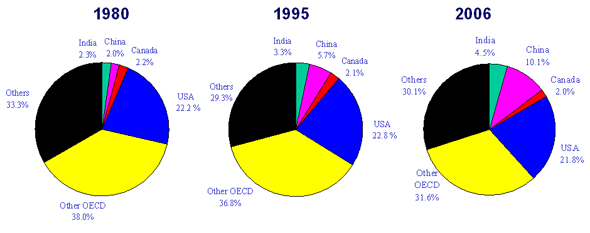
Based on constant 2005 international $, PPP adjusted.
Source: World Bank, World Development Indicators
Chart 2 : The evolution of the world’s major countries. the top dozen economies.
Based on GDP at Current Exchange Rates
(US$Trillions)
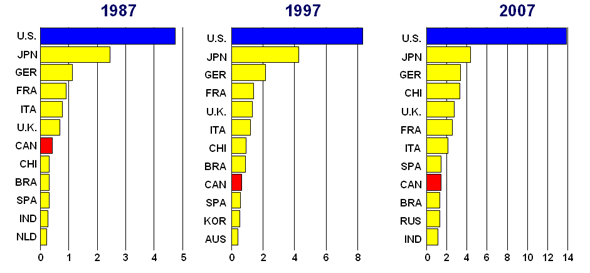
Source: International Monetary Fund, World Economic Outlook, April 2008.
Chart 3 : Global supply chains: developing countries like China and India are not yet the location for innovative value-added production.
I-Pod chain of value-added

Chart 4 : Despite G-8 dominance, non-OECD countries are rapidly growing players in global science and innovation.
R&D expenditure in 2005
(circles reflect size of spending in billion USD PPP)
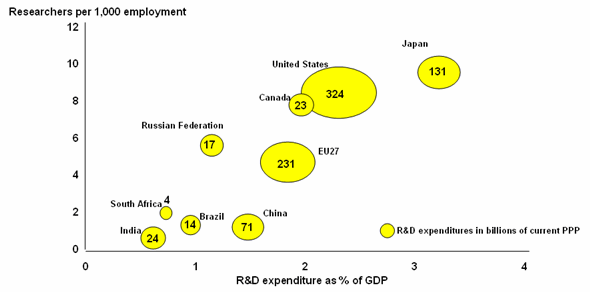
Chart 5: A country’s living standards and productivity go hand-in-hand.
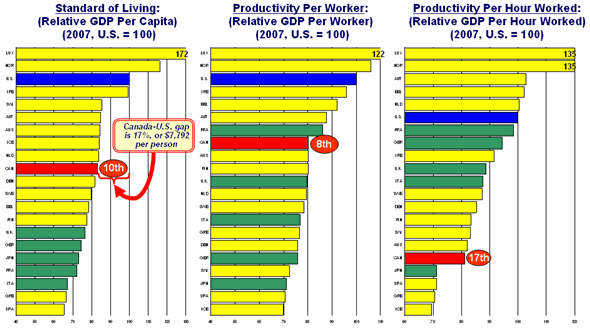
Source:
The Conference Board and Groningen Growth and Development Centre, Total Economy Database, January 2008,
http://www.conference-board.org/economics/
Relative GDP converted to 2007 price levels with updated 2005 EKS PPPs
Chart 6: Productivity is not just a concept, it matters to workers and families.
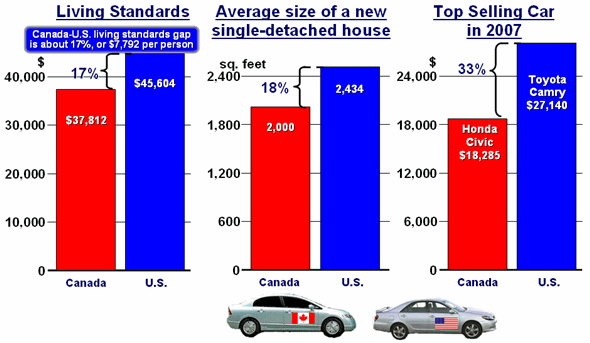
Note: Living standards are Real GDP converted to 2007 price levels with updated 2005 EKS PPPs. Car prices are from www.carquotes.ca, Lowest MSRP plus freight. House sizes are taken from MacLean’s, March 19, 2007, Smaller homes cheaper cars, John Intini.
Chart 7: Competitiveness matters, and in today's global economy, being competitive is a complex, ongoing challenge...macroeconomic environment.

* Includes all levels of government.
** Adjusted to exclude certain government employee pension liabilities to improve comparability with other countries’ debt measures.
Sources: OECD Economic Outlook, No. 83 (June 2008); Statistics Canada National Balance Sheet Accounts; Department of Finance calculations.
Chart 8: Competitiveness matters, and in today's global economy, being competitive is a complex, ongoing challenge.microeconomic environment.

* 22% for university (6th)
Source: OECD case studies of open innovation, forthcoming.
Chart 9: Competitiveness means keeping track of one's comparative advantage.
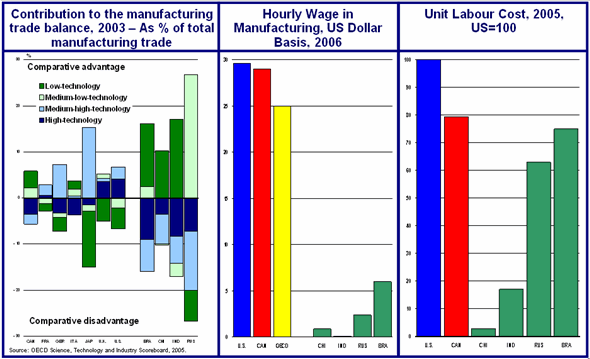
Chart 10: Competitive economies are dynamic and that means change.
Fifteen Leading TSE/TSX Stocks by Market Value 1987, 1997 and 2007
1987
1. Bell Enterprises2. Alcan Aluminum
3. Placer Dome
4. Canadian Pacific Ltd.
5. Seagram’s
6. Echo Bay Mines
7. Nova Alberta
8. Transalta Utilities
9. Inco Ltd.
10. Royal Bank
11. Toronto Dominion Bank
12. Imperial Oil
13. Canadian Tire Corp.
14. Bank of Montreal
15. Laidlaw
15. Moore Corp.
15. Noranda Inc.
1997
1. Northern Telecom Ltd.2. BCE Inc.
3. The Thomson Corp.
4. Royal Bank of Canada
5. CIBC
6. Bank of Montreal
7. Bank of Nova Scotia
8. The Seagram Company Ltd.
9. Toronto Dominion Bank
10. Imperial Oil Ltd.
11. Canadian Pacific Ltd.
12. Imasco Ltd.
13. Bombardier Inc.
14. Barrick Gold Corp.
15. Alcan Aluminium Ltd.
2007
1. Royal Bank of Canada2. Research in Motion Ltd.
3. Manulife Financial Corp.
4. Encana Corp.
5. Toronto-Dominion Bank
6. Suncor Energy Inc.
7. Imperial Oil Ltd.
8. Bank of Nova Scotia
9. Potash Corp. of Sask.
10. Canadian Natural Resources Ltd.
11. Husky Energy Inc.
12. Barrick Gold Corp.
13. BCE Inc.
14. Great West Lifeco Inc.
15. Sun Life Financial Inc.
Chart 11: Public Service Renewal: the imperatives of demographic change and shifting demands.
Public Service has a Demographic Challenge
Average Age of Public Servants: 44
Average age of EXs: 51
Average age of ADMs: 54
ADMs who can retire now with non-reduced pensions: 31+%
Executives who can retire by 2012 with non-reduced pensions: 50%
Public servants who can retire by 2012 with non-reduced pensions: 25%
The Public Service is Canada's largest employer
Canada's largest employer (255K employees)
Canada's most national employer (1600 points of service in Canada)
Canada's most international employer (in over 150 countries)
Canada's most multi-professional workforce (most professions graduated by universities)
Plus, Canada's military (68K soldiers); reserves(25K); RCMP (25K)
Chart 12: Trends in the Canadian economy, government spending and the Public Service, 1983-84 to 2007-08
